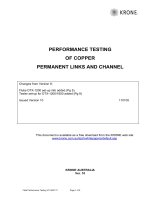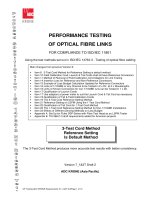Phases of Testing
Bạn đang xem bản rút gọn của tài liệu. Xem và tải ngay bản đầy đủ của tài liệu tại đây (125.57 KB, 8 trang )
Requirements
Specification
Architecture
Detailed Design
Unit Testing
Integration Testing
System Testing
Acceptance Testing
Coding
1 Phases of Testing
1 Introduction
The Primary objective of testing effort is to determine the conformance to requirements specified in the
contracted documents. The integration of this code with the internal code is the important objective.
Goal is to evaluate the system as a whole, not its parts
Techniques can be structural or functional.
Techniques can be used in any stage that tests the system as a whole (System testing ,Acceptance
Testing, Unit testing, Installation, etc.)
2 Types and Phases of Testing
SDLC Document QA Document
Software Requirement Specification Requirement Checklist
Design Document
Design Checklist
Functional Specification Functional Checklist
Design Document & Functional Specs Unit Test Case Documents
Design Document & Functional Specs Integration Test Case Documents
Design Document & Functional Specs System Test Case Documents
Unit / System / Integration Test Case Documents Regression Test Case Documents
Functional Specs, Performance Criteria Performance Test Case Documents
Software Requirement Specification, Unit / System /
Integration / Regression / Performance Test Case
Documents
User Acceptance Test Case
Documents.
3 The “V”Model
Requirement Study
Software Requirement Specification
Requirement Checklist
Software Requirement Specification
Functional Specification Checklist
Functional Specification Document
Functional Specification Document Architecture Design
Architecture Design Detailed Design Document
Coding
Functional Specification Document
Unit Test Case Documents
Design Document
Functional Specification Document
Unit Test Case Document
System Test Case Document
Integration Test Case Document
Unit/Integration/System Test Case Documents
Regression Test Case Document
Functional Specification Document
Performance Criteria
Performance Test Cases and Scenarios
Software Requirement Specification
Regression Test Case Document
Performance Test Cases and Scenarios
User Acceptance Test Case Documents/Scenarios
Regression Round 3
Performance Testing
Regression Round 2
Regression Round 1
Design Review
Architecture Review
Specification Review
Requirements Review
Requirements
Specification
Architecture
Detailed Design
Unit Testing
Integration Testing
System Testing
Code Code Walkthrough
2 Integration Testing
One of the most significant aspects of a software development project is the integration strategy.
Integration may be performed all at once, top-down, bottom-up, critical piece first, or by first integrating
functional subsystems and then integrating the subsystems in separate phases using any of the basic
strategies. In general, the larger the project, the more important the integration strategy.
Very small systems are often assembled and tested in one phase. For most real systems, this is
impractical for two major reasons. First, the system would fail in so many places at once that the
debugging and retesting effort would be impractical
Second, satisfying any white box testing criterion would be very difficult, because of the vast amount of
detail separating the input data from the individual code modules. In fact, most integration testing has
been traditionally limited to ``black box'' techniques.
Large systems may require many integration phases, beginning with assembling modules into low-level
subsystems, then assembling subsystems into larger subsystems, and finally assembling the highest
level subsystems into the complete system.
To be most effective, an integration testing technique should fit well with the overall integration strategy.
In a multi-phase integration, testing at each phase helps detect errors early and keep the system under
control. Performing only cursory testing at early integration phases and then applying a more rigorous
criterion for the final stage is really just a variant of the high-risk "big bang" approach. However,
performing rigorous testing of the entire software involved in each integration phase involves a lot of
wasteful duplication of effort across phases. The key is to leverage the overall integration structure to
allow rigorous testing at each phase while minimizing duplication of effort.
It is important to understand the relationship between module testing and integration
testing. In one view, modules are rigorously tested in isolation using stubs and
drivers before any integration is attempted. Then, integration testing concentrates
entirely on module interactions, assuming that the details within each module are
accurate. At the other extreme, module and integration testing can be combined,
verifying the details of each module's implementation in an integration context. Many
projects compromise, combining module testing with the lowest level of subsystem
integration testing, and then performing pure integration testing at higher levels.
Each of these views of integration testing may be appropriate for any given project,
so an integration testing method should be flexible enough to accommodate them all.
Combining module testing with bottom-up integration.
1 Generalization of module testing criteria
Module testing criteria can often be generalized in several possible ways to support integration testing.
As discussed in the previous subsection, the most obvious generalization is to satisfy the module testing
criterion in an integration context, in effect using the entire program as a test driver environment for
each module. However, this trivial kind of generalization does not take advantage of the differences
between module and integration testing. Applying it to each phase of a multi-phase integration strategy,
for example, leads to an excessive amount of redundant testing.
More useful generalizations adapt the module testing criterion to focus on interactions between modules
rather than attempting to test all of the details of each module's implementation in an integration
context. The statement coverage module testing criterion, in which each statement is required to be
exercised during module testing, can be generalized to require each module call statement to be
exercised during integration testing. Although the specifics of the generalization of structured testing are
more detailed, the approach is the same. Since structured testing at the module level requires that all
the decision logic in a module's control flow graph be tested independently, the appropriate
generalization to the integration level requires that just the decision logic involved with calls to other
modules be tested independently.
Module design complexity
Rather than testing all decision outcomes within a module independently, structured testing at the
integration level focuses on the decision outcomes that are involved with module calls. The design
reduction technique helps identify those decision outcomes, so that it is possible to exercise them
independently during integration testing. The idea behind design reduction is to start with a module
control flow graph, remove all control structures that are not involved with module calls, and then use
the resultant "reduced" flow graph to drive integration testing. Figure 7-2 shows a systematic set of rules
for performing design reduction. Although not strictly a reduction rule, the call rule states that function
call ("black dot") nodes cannot be reduced. The remaining rules work together to eliminate the parts of
the flow graph that are not involved with module calls. The sequential rule eliminates sequences of non-
call ("white dot") nodes. Since application of this rule removes one node and one edge from the flow
graph, it leaves the cyclomatic complexity unchanged. However, it does simplify the graph so that the
other rules can be applied. The repetitive rule eliminates top-test loops that are not involved with module
calls. The conditional rule eliminates conditional statements that do not contain calls in their bodies. The
looping rule eliminates bottom-test loops that are not involved with module calls. It is important to
preserve the module's connectivity when using the looping rule, since for poorly-structured code it may









